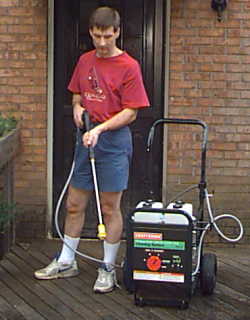

The above are the deck sealer and the power washer that I used on my own decks. This new Craftsman (Sears) Dial-A-Cleaner pressure washer is the best design that I have ever used. It is extremely quick to use and to switch from cleaning my decks to washing my car. The high-quality true synthetic Saver Systems sealer applied very easily and will not support fungus or mold growth like some natural sealers will.
Step 1
Remove all grills, furniture, planters, etc., from deck.
Step 2
Pretreat any grease stains caused by drips from grill by scrubbing with a solution of Dawn and hot water. Even precleaning does not ensure removal of grease from grills.
Step 3
Prewet deck and mix wood cleaner in a five gallon bucket and apply to all deck surfaces with brush or spray. If spray is used, better results will be achieved by working cleaner into the wood with a brush. Some some wood cleaners are not compatible with redwood, so be sure to check manufacturers recommendations.
Step 4
Allow cleaner to remain on the surface for approximately 20 minutes before removing with high pressure spray. A stiff broom and garden hose may be used, but a power washer is faster and more effective. Keep power washer spray moving. Never stop and start with spray gun pointed directly toward deck or scarring may result. Scars can generally be removed or blended into surrounding wood by using a solution of wood cleaner and a stiff brass bristle cleaning brush. Allow to dry. Note: Decks can be forced dried with leaf blowers or squirrel cage type blower used for drying carpets.
Before application, wood must be visually dry and porous. Drop a few droplets of water onto the wood. If water absorbs into the wood in 1 to 2 seconds, then wood is ready for treatment.
Use plastic and/or drop cloths to mask off surrounding shrubbery, foliage, glass, siding, masonry, sidewalks, patios, and all other non-targeted surfaces. Remember, every 5 minutes of masking saves 15 minutes of time cleaning off overspray. Clean overspray immediately with a soapy, wet rag.
Step 5
Apply water repellent. Use a sponge mop (preferred method) or an airless sprayer with a .011 to .021 spray tip. (Fluid pressure between 250 to 500 psi) or a pump up spray applicator. Always brush or sponge mop material into wood after spray application to ensure even coverage and maximum penetration.
Treat vertical surfaces first. Apply two wet on wet applications (see label) to the outside of railings and benches. If spray applied, work each application in with a brush to ensure even coverage and penetration. Apply only one coat to the underneath side of second story decks. Note: When spraying railings and spindles, use heavy cardboard as shields on the opposite side. This will help prevent overspray on the yard or on deck flooring, etc. Overspray that is allowed to dry may be difficult or impossible to remove from siding or masonry.
Treat horizontal surfaces last. Apply first application liberally to 30 to 40 square foot sections at a time, stopping at natural breaks. Use either a soft bristle push broom, or a sponge mop to brush in material and ensure even coverage and maximum penetration.
Apply a second application before the first application becomes dry, generally 15 to 30 minutes after the first application. It's all right to walk on treated surfaces, but remember to immediately brush out shoe prints, etc. Inspect the job thoroughly and brush out drip spots and/or puddles caused by overspray or application, aiming for a smooth, uniform application. Note: When installing product using air spray equipment, one application may be adequate. Remember to back brush all spray applications.
Step 6
Remove drop cloths and masking tape.
Step 7
Inspect all surrounding non-targeted surfaces for overspray and clean immediately. Vigorously remove any spots with a clean rag dipped in cleaning solution and water. Overspray that is allowed to dry will be very difficult to remove.
Step 8
It's important that the treated deck remain dry for 8 to 12 hours after treatment. If rainfall occurs before treatment is thoroughly dry, ponding water will cause the horizontal surfaces to dry unevenly and appear splotchy. Sweep or broom water from deck immediately after a rainfall if treatment is not yet dry. If rainfall is predicted before 12 hours, precautions should be taken to cover entire deck with plastic. Secure plastic with stakes.